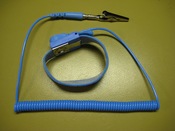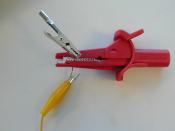METHOD
- Set p the equipment as shown on the diagram.
- One meter length of wire is fixed to a one meter ruler.
- The first crocodile clip is clipped to the wire at the 0cm position on the one meter ruler.
- The second crocodile clip is clipped to the 10cm position.
- The power supply is turned on. The voltage and current are then read of the ammeter and voltmeter, and recorded.
- The power supply is then turned off and the second crocodile clip is moved to the 20cm position.
- Then the power supply is turned and you record the readings from the ammeter and voltmeter.
- Then you turn the power off and move the clip to the next position, you do that until you get to 90cm then you stop.
- After you do that, it is best to repeat the same thing from the beginning at least three time to get fair and accurate results.
BACKGROUND INFORMATIOMS
Current can easily pass through a piece of copper connecting wire. It does not pass trough as easily in a thin nichrome wire of an electric fire element. This wire has much more resistance. Energy has to be spent to force electrons through it. And heat comes off as a result.
All conductors have some resistance but:
- Long wires have more resistance than the short wires.
- Thin wires have more resistance than thick wires.
- Nichrome wire has more resistance than copper wire of the same size.
Resistance is calculated using this equation:
VOLTAGE
RESISTANCE =
CURRENT
The unit of resistance is the ohm
Here is an example:
If there is a voltage of 12 volts across this nichrome, then a current of 4 amperes flows through.
So: 12
Resistance = ohms
4...


